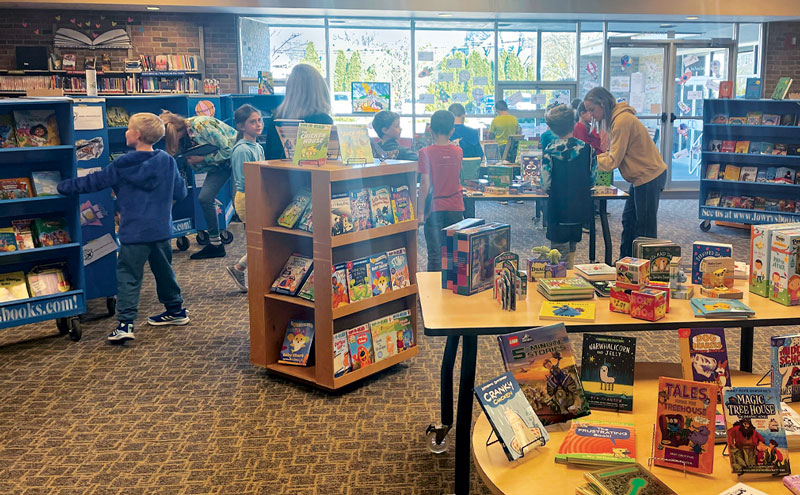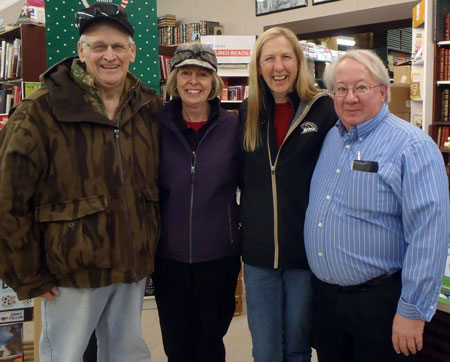Partnering with Indie Bookstores on Book Fairs
Librarians cite flexibility, close attention, and other reasons for working with smaller bookstores.
 |
A school fair created with Michigan’s Lowry’s Books, run by Tom Lowry (below image). |
Related reading: |
Cat Kerns could not imagine that Tom Lowry would be willing to lug his book fair setup halfway across lower Michigan to get to her middle school in Saginaw. It’s about three and a half hours by van from Lowry’s two bookstores in southern Michigan to the librarian’s school.
But Kerns, then president of the Michigan Association of School Librarians, had taken note of Lowry’s can-do attitude at the group’s annual conference, where he was a vendor. So she asked him. He said yes. And he came to Saginaw all the way from Sturgis.
“I was having a hard time finding a book fair I liked and that wasn’t sending me junk rather than books,” Kerns recalls, referring to the toys and software that are often part of a book fair put on by Scholastic, the world’s largest publisher and distributor of children’s books. Another problem was timing: Scholastic wasn’t available in the October week that coincided with parent conferences at the school. Kerns knew that no other week would get as much traffic for the fair.
Kerns says the book selection from Lowry has always been good, including all her requests as well as $1 and $2 “super specials” so that every child could walk away with a new book. “It’s the extra personal touch,” she adds. “That’s the Tom thing.”
Indeed, Lowry sees his success directly linked to his responsiveness to customers, which he fleshes out with deep knowledge of children’s books. He’s been in the book business—first as the manager of big box stores and then with his own book and toy shops—for 40 years. He started putting on book fairs 25 years ago with one local school that was unhappy with Scholastic. In a few years, he realized that the demand—and opportunity—was larger.
Now he does more than 100 fairs a year in Michigan, Ohio, Indiana, and Illinois.

Finding an alternative
The nation’s more than 2,000 independent bookstores have a fraction of the total business in book fairs, which come in at least four formats: traditional fairs held in schools; in-store fairs where parents and children visit the partnering bookstore; online fairs; and combinations of these. No matter the type, from the school point of view, fairs aim to raise money (usually for the school library or the parent-teacher group) and put books in the hands of children.
The preponderance of in-school fairs are run by Scholastic. In an email, Allyson Barkan, a spokesperson for Scholastic, wrote that on average Scholastic helps schools host over 100,000 fairs a year, raising more than $200 million in cash, resources, and books for school and classroom libraries. “We are very proud of the scale of our impact and the wide range of schools and communities we serve.”
Several other book fair companies do business nationally or regionally, including Literati. Barnes & Noble offers in-store and online fairs.
Yet the bigger guys don’t always work out. Then, it’s not uncommon for school librarians to find a satisfying alternative in independent bookstores, which have enjoyed a resurgence nationally in the past three years.
Different flavors
Josh Ryan, a school librarian in the Milwaukee area who runs the website Picture Book Brain, has collected opinions about book fair providers from professional listservs. In the past few years, librarians have complained about declining profits and “getting the same books as last year” from the big companies. Some of the problem probably stems from supply-chain issues, he adds. Nonetheless, Ryan calls independent bookstores “one of the most overlooked options” and notes on his website that some librarians say they do better financially with them.
Independent bookstores often work to position themselves as community cultural hubs, which makes them prize connections with local schools. For their part, schools often like patronizing local businesses, especially if convenience, price breaks, and book selection are comparable to—or better than—the national or regional competition.
Nonetheless, many independent bookstores don’t do fairs, and others have decided that only the in-store or online fairs bring in enough profit. Preparing a collection of books to go out to a school as well as the logistics of a fair are demanding, even if the publicity is largely left to the school.
Politics and Prose, a large, well-established independent bookstore in Washington, DC, holds in-store book fairs only. During the designated book fair week, a part of all sales to customers with a school connection—mainly parents and their children—goes to the school. The store also helps parents buy books for the school from a librarian or teacher “wish list.”
In-person preferred
However much heavy lifting they require, in-school book fairs usually are best at raising money and sparking interest in reading, many school librarians say. Nothing quite replaces turning the pages of a new book that might soon be your very own. And some schools who avail themselves of in-store or online fairs with a local bookstore also put on an in-school Scholastic book fair.
“The kids want to browse the variety of books, and adults (educators and parents) want to do the same,” wrote Sarah Irvin of Denver’s Second Star to the Right Books in an email.
“My kids love it—to go pick out their stuff themselves,” adds Kerns, the Saginaw Township district librarian. “Sometimes that’s all it takes to get a child to read.”
But a fair is only as good as the books that are included, she notes. “I’ve learned that just because adults think a book is an award winner doesn’t mean kids like it. I usually tell [Tom] to surprise me because he does a great job. A fair is another way to know what kids’ reading choices are.”
 Giving customers what they want
Giving customers what they want
Other educators have signed up with Lowry because he pays close attention to what they don’t want as well as what they do. In recent years, he says, that has meant a growing number of religious schools—Catholic, Baptist, Lutheran, and Muslim—have become customers.
Some schools request books with no LGBTQIA+ themes, Lowry says. Others have different reasons to exclude content: “Some say no Harry Potter. A high school might request no hot and heavy romances or [books featuring] drugs.” Lowry still buys such books for his store and for other schools, but he always honors school preferences. He also offers some slightly more generous deals than Scholastic, especially for schools that are small and don’t make as much money at fairs.
His own profit margin for book fairs can be “razor thin,” Lowry says, but he sticks with fairs because he loves children’s books and because the higher volume of sales draws notice from New York publishers. That in turn helps him get publicity about new books and the maximum discounts.
Over the years, Kerns has recommended Lowry to many colleagues. “I love that we can support him,” she says, “because he’s a small bookseller.”
Bess Keller is a senior contributing editor for the opinion section of Education Week.
RELATED
The job outlook in 2030: Librarians will be in demand
The job outlook in 2030: Librarians will be in demand
ALREADY A SUBSCRIBER? LOG IN
We are currently offering this content for free. Sign up now to activate your personal profile, where you can save articles for future viewing






Add Comment :-
Be the first reader to comment.
Comment Policy:
Comment should not be empty !!!